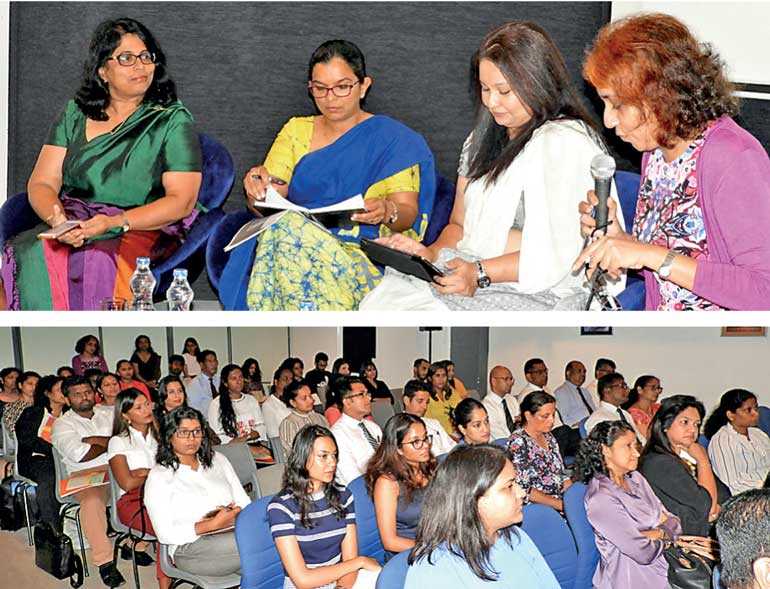Tuesday Apr 23, 2024
Tuesday Apr 23, 2024
Wednesday, 19 September 2018 00:00 - - {{hitsCtrl.values.hits}}
 ‘The roadmap to increase the female labour force participation in the private sector of Sri Lanka,’ compiled by the Taskforce for the National Human Resources Development Council (NHRDC) of Sri Lanka, was presented at the recently held HR-IR Forum of the Employers’ Federation of Ceylon (EFC).
‘The roadmap to increase the female labour force participation in the private sector of Sri Lanka,’ compiled by the Taskforce for the National Human Resources Development Council (NHRDC) of Sri Lanka, was presented at the recently held HR-IR Forum of the Employers’ Federation of Ceylon (EFC).
The fourth edition of the HR-IR forum under the banner of ‘Discourse on Enhancing the Female Labour Force Participation’ brought together several experts from the NHRDC’s Taskforce to elucidate on the selected theme of the forum.
The panel comprised Chiranthi Cooray, Chief Human Resource Officer/Deputy General Manager Human Resources of HNB, Eranthi Premaratne, Director Sustainable Business of MAS Kreeda and Gayani De Alwis of Women in Logistics and Transport (WILAT). The session was moderated by Ayomi Fernando, Head of Training at the EFC.
The current female labour force participation here at home is around 36%. This manifests that a disproportionate majority of women still remains outside the labour market with no access to wages, pensions and other benefits tied to gainful employment as the recently released NHRDC report illustrates. Among the contributing factors are archaic legislation, lack of access to vocational training and socio-cultural norms.
Dinesh Weerakkody, Chairman, NHRDC surmises: “Greater female participation in our workforce is critical for our future economic success and has the potential to transform our economy and society. Any nation that fails to harness the energy and talent of its women will underperform economically. The Government has set a target to increase the female labour force participation from 36% to 40% by 2025. It’s now the responsibility of both the public sector and the private sector to work towards this target as a team.”
To increase the female labour force participation (FLFP) to 40% by 2025 the Taskforce identifies five-strategic areas in which interventions are required: National policy and labour law reforms, HR policy interventions in the public and private sectors, incentivising the private sector to hire more females, social sensitisation through public debate via mass media and education reforms.
Taking the audience through the above recommendations, Cooray in her opening remarks, observed that the portrayal of females in school text books and media largely shape the general consensus of the woman’s role in society.
“Opportunities must be created for target groups such as young mothers to join the labour force. However, the challenges such as work-life balance, including child care, elderly care and workplace harassment need to be addressed at the same time. Everyone can do something to make the situation better.”
Throwing light on certain measures which have already been put in place by the relevant ministries and departments, including full maternity benefits offered irrespective of the number of children, formulation of day care guidelines and expanding day care facilities across the island, Cooray further pointed out that the significant number of local households are headed by women.
Deliberating on the much debated topic of imposing quotas on women representation at work, Cooray opined that the exercise is not very effective and that organisations need to be “both sensitive and sensible” when deploying women, for instance, in situations of transfers.
Remarking that as a whole South Asia lags behind in FLFP, Gayani De Alwis of WILAT noted that less than 3% of women are employed in the logistics and transport sector. “Given the fact that we are increasingly becoming a logistic hub, this is a serious concern.” It was also observed that many female undergraduates are unaware of the career opportunities available. Mentoring programmes and a focused approach were also called for by the panel.
Despite the apparel industry being a women-centric one, employing nearly 70% of women, the opportunities for career progress within the industry, to reach higher levels of the organizational hierarchy are hampered, observed Premaratne.
The female workforce, as Premaratne explained, is largely confined to the operational level. Lobbying for zero-harassment and discrimination policies, flexible working hours and child care centres, the MAS official also stressed on the importance of setting goals. “Because what gets measured, gets done.”
Citing the experiences at exit interviews, Premaratne averred that setting up of child care centres can spur FLFP as most females are found to be resigning due to practical difficulties in tending to young children.
The panel discussion was followed by an interactive dialogue with the participants which solicited further input towards the discourse.